10–14 minute read
Routine Care
fertilizing
Do not fertilize perennials, woody plants or subshrubs. Fertilizing now stimulates new growth that will not harden off properly in the fall, increasing the likelihood of frost and freeze damage.
mulching
To conserve moisture and suppress weeds, mulch established plants to a depth of 2 to 3 inches. New plantings should be mulched only to a depth of about 1 inch. Deeper mulch can cause drought stress. Keep mulch away from plant crowns because trapped moisture can promote rot and disease.
Find the best mulch for your situation
How to apply mulch
watering
Most plants need 1–1.25 inches of water per week. Because hard downpours can run off without soaking in, plants can need water even after a 3-inch rainfall.
In a drought, use longevity as a guide: water trees first, then shrubs, then perennials.
Special tasks
planting & Propagating
- Take semi-hardwood cuttings of evergreens and many other shrubs.
- Divide and transplant bearded iris. It is safer to propagate daylilies in mid- to late September because some cultivars rot when divided or transplanted in hot, humid conditions.
- Plant fall-flowering bulbs: lycoris (spider lily), colchicum (autumn crocus), and sternbergia.
- Sow perennial seeds outdoors: hollyhock, delphinium and stokesia. Lay the finished flower stalks of foxglove on the ground where you want new plants to grow or sprinkle the seeds from the dried pods.
- Start seeds of cool-weather annuals indoors for for fall planting. Try foxglove, pansy, alyssum, snapdragons, ornamental cabbages or kales, and primroses. Pansy seeds germinate well when stored in the refrigerator (not the freezer) for 10 to 14 days before planting.
pruning
| Jan | Feb | Mar | Apr | May | Jun | Jul | Aug | ||||||||||
|---|---|---|---|---|---|---|---|---|---|---|---|---|---|---|---|---|---|
| TREES | |||||||||||||||||
| shade | |||||||||||||||||
| bleeder | small branches | ||||||||||||||||
| fruit | |||||||||||||||||
| SHRUBS | |||||||||||||||||
| summer-blooming | after bloom | ||||||||||||||||
| spring-blooming | after bloom | ||||||||||||||||
| broadleaf EG | dieback | ||||||||||||||||
| needle EG | |||||||||||||||||
| HERBACEOUS | |||||||||||||||||
| grasses | |||||||||||||||||
| flowers | pinch, deadhead | ||||||||||||||||
- Cut off the faded flowers of annuals, phlox, shasta daisy and daylily to encourage a second flowering (perennials) or continual bloom (annuals). If annuals are spindly or leggy, trim them back by as much as ½ their current height.
- Do not prune shrubs. Pruning now will promote tender new growth that cannot survive the cold.
- Watch for root suckers on grafted roses and remove them promptly. Suckers often have foliage that is distinctly different from the top graft. They are usually very vigorous and can steal all of the resources from the top graft, which is the rose that you purchased.
- If needed, prune small tree branches, no longer than 18 inches, of ‘bleeder’ trees like maple, elm, birch, dogwood and styrax.
- You can prune off water sprouts by gentle rubbing.
- Deadhead crape myrtles, but only prune branches with a diameter less than that of a pencil.
soil Test
It is a good idea to test your soil every 2–3 years so that you can adjust pH and fertilize more accurately. Testing is free from April–November. You can pick up and drop off soil boxes, forms, and sampling instructions 8am–5pm M–F in the lobby of the Extension Office: Bonnie B Davis Center, 1020 US-70W.
Learn more about soil testing
problems
disease
Use preventive measures for blackspot, powdery mildew, cankers, rust, and botrytis on roses.
pests
Beneficial insects share the same plants as insect pests. To protect beneficials, use low-toxicity pesticides when possible, spray only if needed and spray at dusk when pollinators are no longer active. Always read and follow label directions for safe pesticide application.
Click on a pest name in the pest calendar below to learn more.
| Jan | Feb | Mar | Apr | May | Jun | Jul | Aug | Sep | Oct | Nov | Dec |
|---|---|---|---|---|---|---|---|---|---|---|---|
| Emerald ash borer | |||||||||||
| tent caterpillar | |||||||||||
| black vine weevil | |||||||||||
| spider mites | |||||||||||
| scales, slugs | |||||||||||
| aphids, lace bugs | |||||||||||
| bagworm | pick bags | ||||||||||
| boxwood leaf miner | |||||||||||
| ironweed longhorn borer | |||||||||||
| flatid planthopper Japanese beetle CATERPILLARS: genista broom moth silvery checkerspot fall webworm | |||||||||||
| twospotted spider mite kudzu bug | |||||||||||
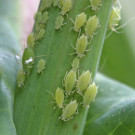 Aphids are usually green but can be many other colors. They attack tender new plant growth. Fortunately, they can be washed off with a forceful stream of water. Severe infestations can be controlled with the relatively environmentally benign insecticidal soaps.
Aphids are usually green but can be many other colors. They attack tender new plant growth. Fortunately, they can be washed off with a forceful stream of water. Severe infestations can be controlled with the relatively environmentally benign insecticidal soaps.
 Japanese beetles vary in number from year to year. Control by any method is difficult to achieve unless it covers a significant area. This requires careful monitoring and the coordinated effort of an entire neighborhood. A recommended alternative is to keep plants healthy (weak plants are more susceptible), to remove beetle attractants such as prematurely ripened or diseased fruit and to plant resistant species. The link gives details on beetle lifecycle, monitoring, control, and species susceptibility.
Japanese beetles vary in number from year to year. Control by any method is difficult to achieve unless it covers a significant area. This requires careful monitoring and the coordinated effort of an entire neighborhood. A recommended alternative is to keep plants healthy (weak plants are more susceptible), to remove beetle attractants such as prematurely ripened or diseased fruit and to plant resistant species. The link gives details on beetle lifecycle, monitoring, control, and species susceptibility.
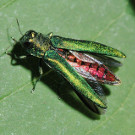 Emerald ash borers have been confirmed in Orange County. They attack all species of native ash as well as our native white fringetree. The top of the crown begins to thin and partially die (sprouting from the main stem of the tree may also occur), followed by death within 2–5 years. While the borers spread a few miles per year by flight, the main route of spread is from contaminated firewood. Interstate movement of EAB-host wood and wood products is prohibited for all of NC. However, movement within our state is not. Please be cautious when purchasing or accepting firewood, wood chips, etc. if you suspect that your trees are infected, please report the location and descriptions of potentially infested trees to 800-206-9333 or newpest@ncagr.gov.
Emerald ash borers have been confirmed in Orange County. They attack all species of native ash as well as our native white fringetree. The top of the crown begins to thin and partially die (sprouting from the main stem of the tree may also occur), followed by death within 2–5 years. While the borers spread a few miles per year by flight, the main route of spread is from contaminated firewood. Interstate movement of EAB-host wood and wood products is prohibited for all of NC. However, movement within our state is not. Please be cautious when purchasing or accepting firewood, wood chips, etc. if you suspect that your trees are infected, please report the location and descriptions of potentially infested trees to 800-206-9333 or newpest@ncagr.gov.
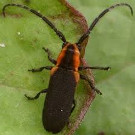 Ironweed longhorn borers attack many species in addition to ironweed, including coneflowers (purple coneflowers, sunflowers, heliopsis, etc.), bloodwort, verbesina, turtleheads, fall-blooming anemones, and even shrubs like beautyberries. The beetle creates a series of wounds in which eggs are laid, then girdles the stem below the egg holes. Cut off the wilted stem below the lowest wound and dispose — don’t compost — so that larvae cannot mature.
Ironweed longhorn borers attack many species in addition to ironweed, including coneflowers (purple coneflowers, sunflowers, heliopsis, etc.), bloodwort, verbesina, turtleheads, fall-blooming anemones, and even shrubs like beautyberries. The beetle creates a series of wounds in which eggs are laid, then girdles the stem below the egg holes. Cut off the wilted stem below the lowest wound and dispose — don’t compost — so that larvae cannot mature.
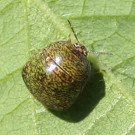 Kudzu bugs are a new pest from India and China that look somewhat like an olive lady beetle. They feed on all types of legumes (note that wisteria is a legume) and congregate on figs, magnolias, bronze fennel, redbuds, roses and peppers. Because they are so new, control strategies are still experimental. Carefully brushing them into soapy water is one approach (they release an irritant when crushed). Some predatory insects like assassin bugs and predatory stink bugs appear to be finding them, which may help to control population size.
Kudzu bugs are a new pest from India and China that look somewhat like an olive lady beetle. They feed on all types of legumes (note that wisteria is a legume) and congregate on figs, magnolias, bronze fennel, redbuds, roses and peppers. Because they are so new, control strategies are still experimental. Carefully brushing them into soapy water is one approach (they release an irritant when crushed). Some predatory insects like assassin bugs and predatory stink bugs appear to be finding them, which may help to control population size.
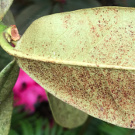 Lace bugs can attack new growth, usually only on azalea/rhododendron, but sometimes on pyracantha, cotoneaster, quince or hawthorne. Dark spots about the size of a pinhead on the lower leaf surface are diagnostic. The best defense is to plant genetically resistant varieties and to maintain plant vigor. For control of severe infestations where there is no evidence that natural predators are present, repeated applications of insecticidal soap or horticultural oil can be effective. When a history of lace bug infestation exists, insecticides can be applied to the lower leaf surface, usually two applications approximately two weeks apart. Monitor the plants about once a month for reinfestations.
Lace bugs can attack new growth, usually only on azalea/rhododendron, but sometimes on pyracantha, cotoneaster, quince or hawthorne. Dark spots about the size of a pinhead on the lower leaf surface are diagnostic. The best defense is to plant genetically resistant varieties and to maintain plant vigor. For control of severe infestations where there is no evidence that natural predators are present, repeated applications of insecticidal soap or horticultural oil can be effective. When a history of lace bug infestation exists, insecticides can be applied to the lower leaf surface, usually two applications approximately two weeks apart. Monitor the plants about once a month for reinfestations.
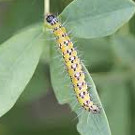 Genista broom moth caterpillars can rapidly defoliate a baptisia.
Genista broom moth caterpillars can rapidly defoliate a baptisia.
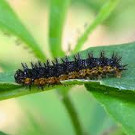 Silvery checkerspot caterpillars can defoliate coneflowers such as sunflowers, false sunflowers, purple coneflowers, and black-eyed susans. The checkerspot is a nice butterfly and the caterpillars usually do not require any control, but in some years they can be destructive. For control, caterpillar-specific approaches are Bt, Bacillus thuringiensis for small caterpillars (½ inch long or less) and spinosad for larger caterpillars. Bt has only a short residual activity, so multiple applicatons may be required. Feeding is required for these to work, so some damage will still occur.
Silvery checkerspot caterpillars can defoliate coneflowers such as sunflowers, false sunflowers, purple coneflowers, and black-eyed susans. The checkerspot is a nice butterfly and the caterpillars usually do not require any control, but in some years they can be destructive. For control, caterpillar-specific approaches are Bt, Bacillus thuringiensis for small caterpillars (½ inch long or less) and spinosad for larger caterpillars. Bt has only a short residual activity, so multiple applicatons may be required. Feeding is required for these to work, so some damage will still occur.
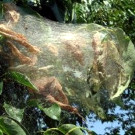 Fall webworm infestations resemble those of tent caterpillars, but the timing and location differ. Tent caterpillars are active in spring and make their webs in tree crotches, often in wild cherry. Fall webworms appear in mid to late summer and form webs at the ends of branches. Although webworms can completely defoliate a tree, healthy established trees usually suffer no permanent injury. Treatment can be beneficial for young, newly-planted trees. Fall webworm populations are usually kept at low levels by their many natural enemies, such as birds, predaceous insects like assassin bugs and parasitic insects like parasitic wasps.
Fall webworm infestations resemble those of tent caterpillars, but the timing and location differ. Tent caterpillars are active in spring and make their webs in tree crotches, often in wild cherry. Fall webworms appear in mid to late summer and form webs at the ends of branches. Although webworms can completely defoliate a tree, healthy established trees usually suffer no permanent injury. Treatment can be beneficial for young, newly-planted trees. Fall webworm populations are usually kept at low levels by their many natural enemies, such as birds, predaceous insects like assassin bugs and parasitic insects like parasitic wasps.
 Twospotted spider mites enjoy hot, dry weather and can attack many different species. They are difficult to see without a magnifying lens. Symptoms include bleaching, stippling and webbing on leaves. A strong spray of water on leaf undersides can offer some control. For more severe infestations, consider insecticidal soaps or horticultural oil spray.
Twospotted spider mites enjoy hot, dry weather and can attack many different species. They are difficult to see without a magnifying lens. Symptoms include bleaching, stippling and webbing on leaves. A strong spray of water on leaf undersides can offer some control. For more severe infestations, consider insecticidal soaps or horticultural oil spray.
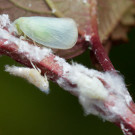 Flatid planthopper nymphs look like mealy bugs at first glance, but they usually do little damage and do not require treatment.
Flatid planthopper nymphs look like mealy bugs at first glance, but they usually do little damage and do not require treatment.
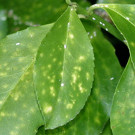 Scales are divided into two groups, armored and soft, based on their coverings. Armored scales usually have several generations a year, can kill woody plants and must be controlled when numerous. Soft scales have a single generation yearly, reduce plant vigor and can lead to unsightly sooty mold, but do not usually kill plants. Often, scale is controlled by beneficial predators. If necessary, try one of the following: 1) Prune out heavily infested shoots/branches 2) On deciduous species, apply horticultural oils or soaps, which will kill all scale stages. 3) Use a registered insecticide to kill crawlers. Monitor for crawlers (tiny, pale yellow specks) by using double-sided sticky tape on several branches.
Scales are divided into two groups, armored and soft, based on their coverings. Armored scales usually have several generations a year, can kill woody plants and must be controlled when numerous. Soft scales have a single generation yearly, reduce plant vigor and can lead to unsightly sooty mold, but do not usually kill plants. Often, scale is controlled by beneficial predators. If necessary, try one of the following: 1) Prune out heavily infested shoots/branches 2) On deciduous species, apply horticultural oils or soaps, which will kill all scale stages. 3) Use a registered insecticide to kill crawlers. Monitor for crawlers (tiny, pale yellow specks) by using double-sided sticky tape on several branches.
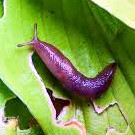 Slugs can attack soft new growth. Holes in leaves or on leaf margins and a silvery slime trail in the morning indicate slug damage. Because slugs hide under boards, stones or debris during the day, populations can be reduced by managing habitat and trapping. Alternative approaches are either ineffective (barriers like diatomaceous earth or copper) or toxic (metaldehyde baits are toxic to pets/children; iron phosphate baits containing EDTA have been found to be toxic to earthworms). To trap, try laying a board near the target plants. Lift at midday and remove the slugs clinging on the bottom.
Slugs can attack soft new growth. Holes in leaves or on leaf margins and a silvery slime trail in the morning indicate slug damage. Because slugs hide under boards, stones or debris during the day, populations can be reduced by managing habitat and trapping. Alternative approaches are either ineffective (barriers like diatomaceous earth or copper) or toxic (metaldehyde baits are toxic to pets/children; iron phosphate baits containing EDTA have been found to be toxic to earthworms). To trap, try laying a board near the target plants. Lift at midday and remove the slugs clinging on the bottom.
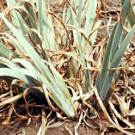 Iris problems depend on the iris type, with beardless types suited to our area being mostly trouble-free. Good sanitation in fall is sufficient for control of many problems. Monitor for healthy foliage and if you see a problem, view the link for a comprehensive list.
Iris problems depend on the iris type, with beardless types suited to our area being mostly trouble-free. Good sanitation in fall is sufficient for control of many problems. Monitor for healthy foliage and if you see a problem, view the link for a comprehensive list.
weeds
For common weeds not mentioned below, try this weed gallery. You can check for the toxicity, groundwater risk and persistance of many weed products in Toxicity of Lawn Chemicals.
- Treat perennial weeds such as wild onion and wild garlic with a broadleaf herbicide when temperatures are above 50°. Be careful to distinguish mock strawberry, an invasive alien, from our native barren strawberry.
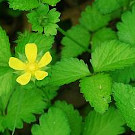 weed mock strawberry
weed mock strawberry wildflower barren strawberry
wildflower barren strawberry - Killing or removing weeds before they seed is critical for control. This is especially important for the two new 'superweeds' below. While both are annuals, they are extremely aggressive and produce copious seed, rapidly colonizing your yard if left unattended.
